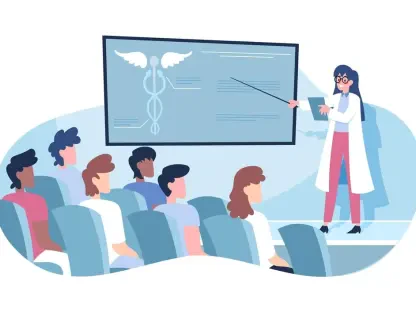In the midst of a global health crisis that tested the resilience of healthcare systems worldwide, the NHS Covid app emerged as a groundbreaking tool within the United Kingdom’s National Health Service (NHS), fundamentally altering the landscape of medical service delivery. Launched at the height of the Covid-19 pandemic, this digital innovation was initially designed to tackle urgent challenges such as contact tracing and vaccination scheduling, serving as a lifeline for millions navigating unprecedented uncertainty. Five years on, its influence continues to resonate, not merely as a response to a momentary crisis but as a catalyst that ignited a broader digital revolution in healthcare. The app’s rapid deployment under intense pressure shattered long-held assumptions about the NHS’s capacity for swift adaptation, proving that technology could bridge critical gaps when stakes were highest. This remarkable achievement has since become a benchmark for what a digitally empowered healthcare system can achieve, inspiring a vision of seamless, patient-focused care that extends far beyond the pandemic’s immediate demands.
The enduring impact of this technological milestone lies in its ability to reshape perceptions and practices within the NHS. It demonstrated that digital tools could be scaled nationally with speed and precision, challenging the narrative of bureaucratic inertia that had long plagued the system. Today, as waiting lists remain a pressing concern, the app’s legacy prompts vital questions about sustaining such innovation in routine operations. How can the momentum of crisis-driven change be maintained in calmer times? What steps are needed to ensure digital solutions are accessible to all, regardless of technological proficiency? These considerations highlight that while the app marked a turning point, the journey toward a fully integrated, digital-first NHS is ongoing, requiring not just tools but a profound shift in culture and collaboration across the healthcare ecosystem.
The Catalyst for Digital Transformation
Rapid Innovation Under Pressure
The launch of the NHS Covid app during the peak of the pandemic stands as a testament to the power of rapid innovation in the face of overwhelming adversity. When the healthcare system was grappling with unprecedented strain, the NHS managed to deploy this digital solution at a national scale in record time, overcoming deeply entrenched barriers to technological adoption. This wasn’t merely about addressing immediate needs like tracking virus spread or scheduling vaccinations; it was a defining moment that showcased the system’s latent potential for agility. Historical resistance to change and outdated infrastructure, which had slowed progress for years, were sidelined by the urgency of the crisis. The app’s swift rollout became proof that with aligned resources and clear purpose, the NHS could achieve digital maturity far quicker than previously thought, setting a new standard for emergency response and technological implementation in healthcare.
This rapid deployment also exposed the stark contrast between pre-crisis digital inertia and what was possible under pressure. Before the pandemic, the NHS often struggled with fragmented systems and a cautious approach to technology, leading to sluggish adoption rates. The app’s introduction flipped this narrative, demonstrating that necessity could drive unprecedented collaboration and resource allocation. It wasn’t just a tool for managing a health crisis; it became a symbol of systemic adaptability, showing that even a sprawling public institution could pivot decisively when lives depended on it. This moment of transformation continues to inform current strategies, as the NHS seeks to replicate such speed in addressing ongoing challenges like service backlogs, ensuring that the lessons of urgency are not lost in peacetime operations.
Shifting Mindsets for a Digital-First NHS
The app’s influence extended beyond its technical capabilities, fundamentally altering mindsets within the NHS and among its stakeholders. Its successful implementation instilled renewed confidence in the system’s ability to embrace digital solutions, even in scenarios far removed from global emergencies. Where once there was skepticism about technology’s role in healthcare, the app’s impact fostered a belief that digital tools could be integral to everyday operations, from patient communications to appointment management. This shift in perspective was crucial, as it encouraged early adopters—clinicians, administrators, and policymakers alike—to champion a digital-first approach. The app became a rallying point, proving that innovation at scale was not a distant dream but a tangible reality, thereby laying the psychological groundwork for broader technological acceptance across the NHS.
Moreover, this change in outlook has had lasting implications for how healthcare delivery is conceptualized. The app’s legacy is evident in the growing recognition that digital solutions can enhance patient-centered care, making services more responsive and accessible. Stakeholders now view technology not as an optional add-on but as a core component of a modern health system, capable of streamlining processes and improving outcomes. This mindset shift has spurred initiatives to integrate digital tools into routine practices, ensuring that the confidence gained during the crisis translates into sustainable progress. As the NHS navigates current pressures, this cultural evolution remains a critical asset, driving efforts to build a system where technology and human care work in seamless harmony to meet societal needs.
Building a Connected Healthcare System
The Power of Interoperability
One of the most significant lessons from the NHS Covid app’s rollout is the critical importance of interoperability in creating an efficient healthcare system. By connecting disparate entities such as hospitals, general practitioner surgeries, and community services through unified digital platforms, the app highlighted how seamless communication could transform service delivery. A notable example is the integration achieved by Central London Community Healthcare NHS Trust with the NHS App, which resulted in a remarkable 20-30% reduction in missed appointments, often referred to as “Did Not Attends.” This tangible improvement underscores how interoperable systems can minimize inefficiencies, ensuring patients receive timely care while optimizing resource use. The app’s success in this regard has reinforced the consensus that fragmented IT systems are a barrier to effective care, pushing the NHS toward a future where connected platforms are the norm rather than the exception.
This emphasis on interoperability also aligns with broader strategic goals within the NHS, particularly the push to enhance patient outcomes through better coordination. The app’s ability to bridge gaps between different care settings demonstrated that technology could serve as a unifying force, reducing administrative burdens and preventing patients from falling through the cracks. Such integration is now seen as a prerequisite for addressing systemic challenges, like long waiting times, by ensuring that information flows freely across the healthcare network. The legacy of the app in this domain is a clarion call for continued investment in connected systems, recognizing that without interoperability, even the most advanced tools risk being underutilized. As the NHS evolves, this focus on seamless digital infrastructure remains a cornerstone of efforts to build a more responsive and cohesive health service.
Streamlining Community Care
The app’s influence on integrating community healthcare into broader digital frameworks marks another pivotal aspect of its legacy. By facilitating connections that bring care closer to home—a priority outlined in the government’s 10-Year Health Plan—the NHS has been able to enhance accessibility for patients who might otherwise struggle with traditional hospital-based services. The app’s role in enabling such integrations has shown how technology can simplify administrative tasks, like scheduling and follow-ups, while ensuring that community providers are looped into the larger healthcare ecosystem. This approach not only improves patient experience by reducing travel and wait times but also alleviates pressure on acute care facilities, allowing them to focus on critical cases. The app’s impact here serves as a blueprint for how digital tools can support localized care delivery in a practical, measurable way.
Furthermore, streamlining community care through digital means addresses a fundamental need for equity in healthcare access. The app’s framework has inspired initiatives to ensure that rural or underserved populations benefit from the same technological advancements as urban centers, narrowing disparities in service provision. By embedding community services within digital platforms, the NHS can better monitor patient needs, coordinate care plans, and prevent health issues from escalating due to lack of timely intervention. This shift reflects a deeper understanding that healthcare must be adaptable to diverse contexts, leveraging technology to meet patients where they are. The app’s contribution to this vision continues to guide efforts in reshaping the NHS into a system that prioritizes proximity and personalization alongside clinical excellence.
Harnessing Data for Proactive Care
Real-Time Insights for Better Decisions
A defining feature of the NHS Covid app’s impact was its ability to harness real-time data for informed decision-making during a public health emergency. By providing insights into virus transmission patterns and identifying at-risk populations, the app enabled the NHS to allocate resources effectively, ensuring that critical interventions reached those who needed them most. This capability marked a significant departure from reactive healthcare models, highlighting how data could drive proactive strategies to mitigate risks before they escalated. Today, this approach remains a vital component of NHS planning, with data informing everything from capacity management to outbreak prevention. The app’s pioneering use of real-time analytics set a precedent for building a health system that anticipates challenges rather than merely responding to them, fundamentally enhancing resilience.
The broader implications of this data-driven paradigm are evident in how the NHS now approaches systemic pressures. The app’s success in optimizing resource distribution during the crisis has inspired ongoing efforts to embed similar analytics into routine operations, ensuring that decision-makers have access to actionable intelligence at all times. This shift is particularly crucial in addressing persistent issues like service backlogs, where understanding demand patterns can help prioritize care delivery. By demonstrating the power of immediate data, the app has underscored that proactive care isn’t just a luxury but a necessity for a modern health service. Its influence continues to push the NHS toward a future where real-time insights are a default tool for safeguarding public health, reducing inefficiencies, and improving overall system performance in both crisis and calm.
Personalizing Patient Experiences
Beyond crisis management, the app’s legacy in data utilization has paved the way for more personalized healthcare experiences within the NHS. By integrating appointment management with predictive analytics, the system can now tailor services to individual patient needs, anticipating issues like missed appointments or health deterioration before they occur. This customized approach, inspired by the app’s ability to process vast amounts of user data, aligns with societal expectations for intuitive, responsive care that feels personal rather than generic. Patients benefit from reminders, tailored health advice, and streamlined access to services, all of which enhance engagement and outcomes. The app’s role in establishing this precedent has been instrumental in shifting the NHS toward a model where technology serves as a personal health assistant, not just a transactional tool.
Additionally, personalizing care through data addresses the growing demand for patient-centered healthcare in a digital age. The app’s framework has encouraged the NHS to explore how insights can be used to build trust and empower individuals in managing their health journeys. Whether it’s predicting when a patient might need a follow-up or identifying barriers to care access, this data-driven personalization ensures that interventions are timely and relevant. Such advancements reflect a deeper commitment to meeting patients on their terms, using technology to bridge gaps in understanding and availability. The app’s influence in this sphere continues to inspire innovations that prioritize the human element of healthcare, ensuring that digital transformation enhances connection rather than creating distance between providers and those they serve.
Overcoming Challenges for Sustained Progress
Behavioral Change and Collaboration
While the technological strides made by the NHS Covid app are undeniable, its story also reveals that sustainable progress hinges on behavioral change across the healthcare spectrum. Adopting new digital tools requires a fundamental shift in mindset among NHS staff and patients, who must embrace technology as a core part of care delivery rather than a peripheral addition. This cultural adaptation is as critical as the tools themselves, ensuring that innovations are used effectively in daily practice. Equally important is collaboration between public and private sectors, leveraging a multi-vendor approach to integrate existing technologies rather than chasing unproven solutions. The app’s success was built on such partnerships, and maintaining this spirit of cooperation is essential to avoid fragmentation and ensure that digital advancements benefit the entire system without leaving gaps in implementation.
Moreover, fostering behavioral change involves addressing resistance at both institutional and individual levels within the NHS. Training programs, clear communication, and demonstrable benefits are key to encouraging staff to adopt digital workflows, while patient education ensures that tools are accessible to diverse demographics. The app’s rollout showed that urgency can drive adoption, but sustaining this in non-crisis contexts requires ongoing engagement and support. Collaboration also means aligning government strategies with private sector innovation, creating a shared vision for digital healthcare that prioritizes scalability and impact. The app’s legacy in this regard serves as a reminder that technology alone isn’t enough; it must be paired with a collective willingness to evolve, ensuring that the NHS builds on past triumphs to create a cohesive, forward-thinking health service for all.
Focused Investment in Existing Solutions
The app’s enduring lesson for the NHS also lies in the need for focused investment in proven, scalable technologies rather than diverting resources to large-scale, untested projects. With funding constraints posing a significant challenge—estimated at £21 billion over the next five years for digital transition—prioritizing existing solutions that have demonstrated impact is paramount. The app itself was a product of urgent, targeted implementation, not endless experimentation, and this approach must guide current efforts to modernize routine services. By enhancing platforms already in use, like those reducing missed appointments through integration, the NHS can build on a solid foundation without risking disruption. This pragmatic focus ensures that digital transformation remains practical and results-driven, addressing immediate needs while laying the groundwork for long-term innovation.
Looking back, the app’s impact also serves as a caution against the allure of novelty at the expense of reliability. Large procurement initiatives, while ambitious, often risk diluting focus and funds that could bolster systems already delivering value. The NHS must navigate these financial pressures by doubling down on interoperability and data utilization, areas where the app proved transformative, to maximize return on investment. Reflecting on this milestone, the path forward involves strategic allocation of resources to refine and expand what works, ensuring that digital tools evolve in step with patient and system needs. The app’s journey offers a clear directive: sustain progress by investing wisely in the present, using past successes as a roadmap to a more connected, efficient healthcare future.









